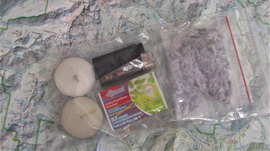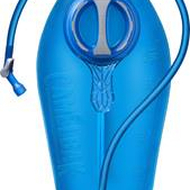Winter hiking survival. Your ideas?
"We're all getting older," my hiking partner said. "What if someone has a stroke, heart attack or breaks a leg? In winter, they would freeze to death waiting for help. We may not be able to carry them out."
"Good point," I replied. "I will get my fire starter kit from my backpack and put it in my day pack. Also, I carry a reflective survival blanket, first aid kit, down jacket and raincoat year round. And straps for making a litter or sling."
Survival gear lives in the bottom of my pack.
My fire starter kit:
- Two votive candles.
- Matches in a separate ziploc bag.
- Small lighter.
- Dryer lint for kindling.
Of course, we use micro-spikes and snowshoes.
I bring extra clothes and a lightweight down comforter in a stuff bag. Pack extra mittens in case mine get wet.
Any other ideas?


Enjoy being online again!
Welcome to the community of good people who base their values on evidence and appreciate civil discourse - the social network you will enjoy.Create your free account
38 comments
Feel free to reply to any comment by clicking the "Reply" button.Beer, Cell phone, Winnebago, Widescreen TV, Netflix, Beer, Bear pepper spray, Coffee & coffee maker, beer.
If you put Vaseline on your dryer lint it will burn slower and make it easier to start a fire. I use vaseline soaked cotton balls that I store in old 35mm plastic film containers. Also, break the lower branches off trees for small and middle size wood. Wood on the ground maybe damp. The lower branches of trees should be dry.
I always hike with red strips of material. If I need to mark a trail, I tie a strip at eye level and I can see it from a distance. Always take all strips out with you! I have been doing this for 30 years. I go off trail often as I live in the woods of MT. I have never left a strip behind.
This is a fantastic idea--Vaseline soaked cotton balls.
@ADKSparky Chapstick works too.
@VulganoBrother My solution is to sit in the bar. 
You're gonna need:
- Bags of animal feces to smear on yourself to discourage bear attacks
- An AR-15 and plenty of ammo against nuclear irradiated mutant cannibal families
- A 9mm against random inbred rapist mountain men
- A case of TNT for various useful purposes
- An emergency shot of Epinephrine
- A good cover story in case of interrogation
I watch a lot of movies. They teach me stuff.
I have done winter climbing, backpacking, back-country skiing in the past. You could use a small bivy sack and 3/4 closed cell foam pad. A handheld green laser pointer is a great signal to show your location and can be seen for miles.
Stay indoors. That's my winter hiking survival tip.
Carrya decent knife or small axe ... a couple of long poles threded through sleeves of two spare jackets .. add a cross brace and you have an emergency stretcher
I carry two straps in the bottom of my pack. Using the straps, we make a litter or travois with hiking poles and survival blanket or jacket.
In my first aid kit, I carry a folding knife.
@LiterateHiker You obviously know what you are doing and are well prepared .... I would prefer a more sturdy blade than a folding knife (assuming it is a standard 3 - 5 inch blade) but its a personal choice.
Please keep posting the wide landscapes and lovely flora out there
With global warming causing massive wildfires, outdoor fires have been banned in Washington State for over 10 years. The era of cutting wood for campfires is gone.
Instead we joke about sitting around the candle lantern, telling stories and lies. While hiking, I don't need a saw or long, sturdy knife.
The last time I used my folding knife was to cut off a section of hose on my Camelbak water reservoir. It had split near the bite valve.
Some times there isn't much you can do.
A friend I worked with did Search & Rescue at the South Rim of the Canyon. One winter his ex-wife was riding alone in the hills W of Prescott, AZ, slipped off her horse and broke her leg before a very cold night. We never did figure out why she called him rather than emergency services -- under some circumstances it's hard to think clearly.
They didn't find her until the next day but somehow the horse stayed with her and kept her through the night -- everybody's quite sure it saved her life.
Even if you're experienced, all you can do is try to cover as many bases as you can and expect to be surprised anyway.
It happens to everyone and 'nobody ever plans to have an accident'.
Just try to stay safe and have fun.
I always carry a lightweight insulating pad in the winter and a pocket knife and sometimes a lightweight tarp shelter. Depends on the hike and who I am with. I am often outside of cell phone service and will let someone know where I am going and when I expect to be back. The most important thing is to be aware and informed about the risks you are taking and take responsibility for your decisions. The most important skill is self-assessment!
I alway carry a lightweight insulating pad to sit on during lunch. Pocket knife, first aid kit, sunscreen, water purification tablets, map, extra food and water, down jacket, raincoat, etc.
My pack is heavy. I believe in being prepared.
@LiterateHiker then again, a heavy pack weighing you down can also make you less safe in some situations. We are always having to choose certain risks in order to avoid others.
True. A heavy pack slows me down.
Good list. You can't prepare for everything, but you have a good selection for many circumstances. How about a bag of dehydrated food for a short, but protracted stay put?
When hiking, I carry a pocketful of roasted almonds, lunch and extra food. Also bring extra water and water purification tablets.
I did not list everything in my day pack. I always bring a headlamp, extra batteries and a Mighty Bright LED carabiner flashlight.
Dryer lint is a very smart idea.
Thank you!
Great list! I’d add warm dry socks. A shelter of some sort, like a tarp or tube tent. Metal mirror (unbreakable) for signaling. Emergency beacon, especially if traveling in avalanche country.
Dry socks are super important hiking or at home. Always have extra socks.
Good idea. I waterproof my boots and gaiters. Never had a problem with wet socks.
Mittens get wet. So I carry extra mittens.
@LiterateHiker Even with gaiters I’ve gotten damp feet - nothing worse!
along with the mirror, a whistle.
There's a whistle built into the chest strap of my Osprey day pack. Karen and I have a signaling system:
Hurt: Two long whistles. Listen for a response. Repeat.
Separated and okay: Three quick whistles. Listen. Repeat.
In my first aid kit, there's a lightweight mirror. This is helpful for getting something out of your eye. In 45 years of hiking over 200 miles/year, I have never had to signal for help.
Get a cellphone and some sort of watch that detects falls and automatically calls 911 with your exact location...
Often there is no cellphone coverage in the mountains.
I NEVER hike alone. What if I get lost or injured? I need someone to provide first aid and go for help.
@LiterateHiker get a satellite phone...
A satellite phone is too heavy.
Some hikers carry a personal locator beacon. You have to pay for a service.
Walkie talkies? You carry one and leave the other at a friends house? Give them hourly updates?
@Cutiebeauty The range on walkie-talkies is NOT sufficient for this. A hiking buddy is best.
I NEVER hike alone. What if I get injured or lost? I need someone to give first aid and go for help.
Scary thoughts should not be part of your kit.
Prepare for cold, bumps, bruises and other "owies", but don't worry about catastrophic events.
Aspirin for heart attack , water food signaling device(mirror, strobe light) stop bleed(found in walmart pharmacy section stops severe bleeding) ace wrap few gauze pads
@bobwjr, @moosepucky
Way ahead of you.
My First Aid Kit lives in my pack.
- QR topical powder to stop bleeding.
- Assorted band aids
- Moleskin for blisters
- Ibuprofen
- Benadryl tablets to stop allergic reactions. Most people don't think about wasp stings.
- Sterile gauze pads and paper tape
- Duct tape (wrapped around my hiking pole)
- Emergen-C for muscle cramps
- Hydrogen peroxide, small bottle
- Neosporin antibacterial ointment.
- Saline eye drops
- Tweezers
- Safety pins
- Bacitracin zinc ointment for wounds.
- Folding knife.
- Mirror (for getting something out of your eye, and signaling).
- Asthma inhaler.
- Paper and pen for leaving notes.
- Water purification tablets.
@LiterateHiker excellent
Good ideas. Perhaps add an emergency signaling device that works where a cell phone won't, or if you can't use the phone but still need to signal?
As I get older, I am considering getting a personal locator device.
Since age 21, I have hiked 200-300 miles per year with 40,000' to 66,000' of elevation gain. Always got out under my own steam. It's not luck. I never hike alone and am careful, especially during the descent.
I know what to bring, how much water I need, how to pick a line, show good judgment and safely hike steep, dangerous terrain. I assess hazards, pace myself, and bring the right equipment.
This can make the difference between hiking safely, or getting injured or killed.
Accidents happens. Near the summit of Mt. Stuart, a newlywed man leaned against a boulder to rest. The boulder fell over the edge, taking him with it. He was killed.
We got my son who travels deep in our mountains a GPS that transmits his coordinates when he needs a mayday. He asked for it for xmas and it really wasn't very expensive.
Hopefully you'll never have to use any of it
Guess what I hand out the most to people on the trail?
-
Benadryl. Surprise! There are wasps and hornets in the woods.
-
Insect repellent. "We didn't think about bugs," idiot parents say. Meanwhile, their kids are covered with mosquito bites.
-
My spare jacket. One woman we occasionally hike with often forgets her jacket.
Actually, I use my first aid kit often. People get hurt. I'm the only person who brings a first aid kit.
Enjoy being online again!
Welcome to the community of good people who base their values on evidence and appreciate civil discourse - the social network you will enjoy.Create your free account
Share this post
Categories
Agnostic does not evaluate or guarantee the accuracy of any content. Read full disclaimer.










